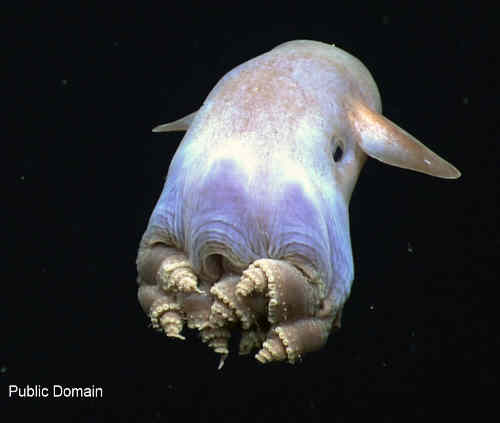Dumbo Octopus (Grimpoteuthis)

Appearance
Dumbo octopuses are small to medium “umbrella octopuses” with a gelatinous body, webbed arms, and distinctive ear-like fins. Most species measure 20–30 cm mantle length; some individuals exceed 1 m total spread. Colors range from pale to reddish and can shift slightly with mood or light.
Distribution
A widely distributed deep-sea group found in all major oceans, from temperate to tropical latitudes, typically along continental slopes, abyssal plains, and seamounts.
Habitat
True bathyal to abyssal dwellers, usually 1,000–4,000 m, occasionally deeper. They hover just above soft sediments where marine snow accumulates and small invertebrates are abundant.
Behavior
They swim by flapping the lateral fins and gently pulsing the webbed arms, conserving energy in the low-food deep sea. Movements are slow and hovering, with sudden jetting when startled. They are generally solitary and cryptic.
Diet
Predominantly small benthic and pelagic invertebrates: polychaete worms, amphipods, copepods, and small crustaceans. They swallow prey whole rather than tearing, which suits the low-energy deep-sea lifestyle.
Reproduction
Dumbo octopuses show continuous or intermittent spawning rather than a single seasonal event. Females may carry eggs at multiple developmental stages, releasing them individually when conditions are favorable. Lifespan is thought to be a few years.
Threats
Current direct threats appear limited due to extreme depths, but potential risks include deep-sea mining, bottom trawling on slopes, and climate-driven changes to carbon flux that supports deep-sea food webs. Many species are poorly known; conservation status is often Data Deficient.
Dumbo Octopus Facts – Deep-Sea Drifter
Named for its ear-like fins, the dumbo octopus glides with remarkable energy efficiency in near-freezing darkness.
Population and Conservation
Unknown for most species; observations rely on submersibles and ROVs. Protection hinges on safeguarding deep-sea habitats before industrial expansion.
Interesting Facts
- “Umbrella” webbing between arms forms a bell-like shape for hovering.
- Unlike shallow-water octopuses, they don’t use ink—there’s no light to obscure.
- ROV sightings often occur near canyon walls and seamounts where currents concentrate food.
FAQs about Dumbo Octopuses
How big do they get?
Most are under 30 cm mantle length, but some can reach over 1 m total spread.
Do they change color?
Mild color shifts occur, likely for signaling or camouflage under ROV lights.
